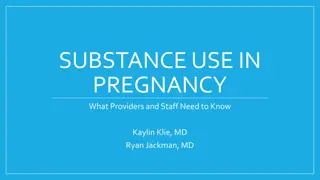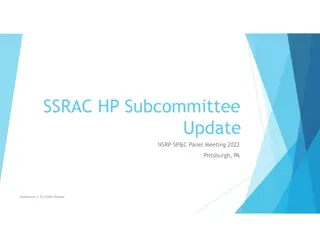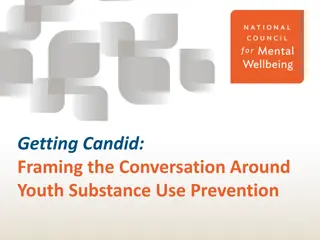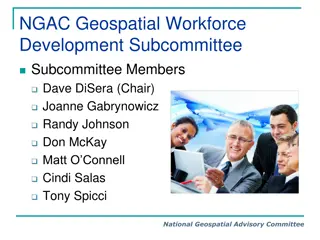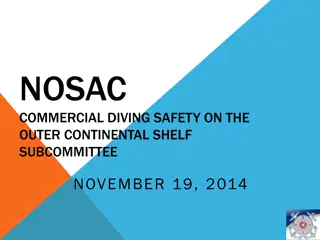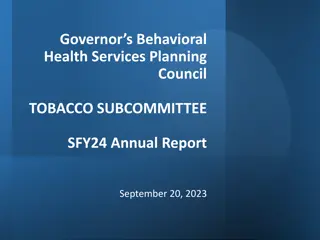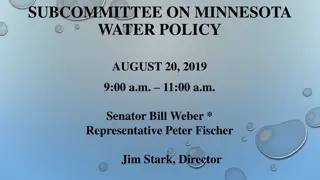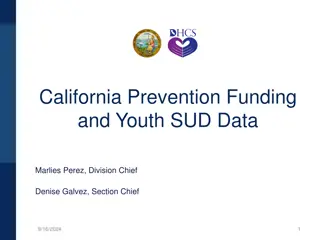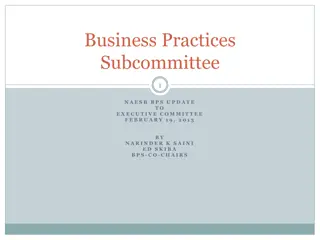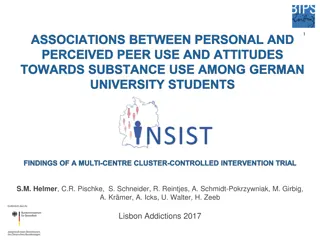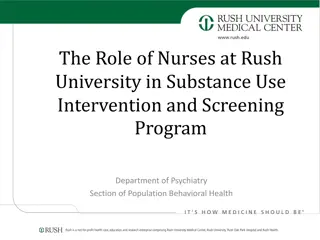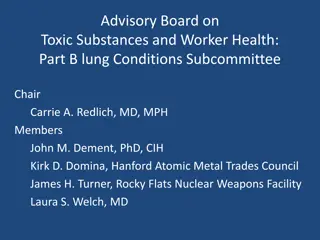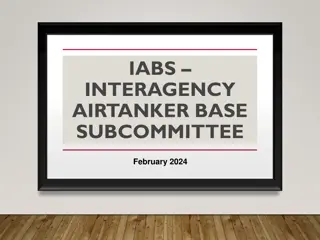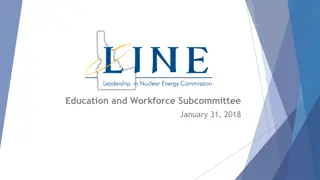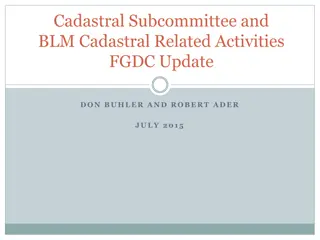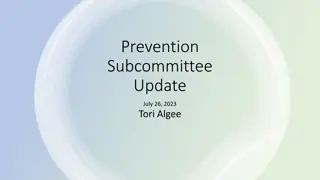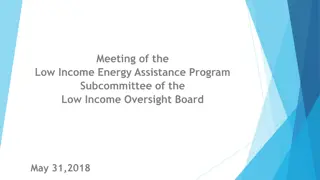Prevention Subcommittee Substance Use Response Group (SURG) Meeting Highlights
The Prevention Subcommittee SURG met on April 25, 2022, to discuss strategies for reducing substance use disorders. The meeting included a call to order, public comment session, member introductions, and an overview of the committee's scope, emphasizing harm reduction and comprehensive prevention efforts. Recommendations were made to relevant entities for enhancing substance use prevention initiatives at the state and local levels.
Uploaded on Oct 11, 2024 | 1 Views
Download Presentation

Please find below an Image/Link to download the presentation.
The content on the website is provided AS IS for your information and personal use only. It may not be sold, licensed, or shared on other websites without obtaining consent from the author.If you encounter any issues during the download, it is possible that the publisher has removed the file from their server.
You are allowed to download the files provided on this website for personal or commercial use, subject to the condition that they are used lawfully. All files are the property of their respective owners.
The content on the website is provided AS IS for your information and personal use only. It may not be sold, licensed, or shared on other websites without obtaining consent from the author.
E N D
Presentation Transcript
PREVENTION SUBCOMMITTEE Substance Use Response Group (SURG) April 25, 2022 11:00 am
1. CALL TO ORDER AND ROLL CALL TO ESTABLISH QUORUM Senator Fabian Do ate
1. Call to Order and Roll Call to Establish Quorum Member SURG Role Committee Role Senator Fabian Do ate Senate Majority Appointee Chair Debi Nadler Advocate/Family Member Member Erik Schoen SUD Prevention Coalition Urban Human Services (Clark County) Member Jessica Johnson Senator Heidi Seevers- Gansert Member Senate Minority Appointee Member
Public Comment Public comment will be received via Zoom by raising your hand or unmuting yourself when asked for public comment. Public comment shall be limited to three (3) minutes per person (this is a period devoted to comments by the general public, if any, and discussion of those comments). No action may be taken upon a matter raised during a period devoted to comments by the general public until the matter itself has been specifically included on an agenda as an item upon which action may be taken pursuant to NRS 241.020.
3. MEMBER INTRODUCTIONS
3. Member Introductions Member SURG Role Committee Role Senator Fabian Do ate Senate Majority Appointee Chair Debi Nadler Advocate/Family Member Member Erik Schoen SUD Prevention Coalition Urban Human Services (Clark County) Member Jessica Johnson Senator Heidi Seevers- Gansert Member Senate Minority Appointee Member SEI Team* *Non-members Subcommittee Support
Committee Scope The Prevention Subcommittee includes harm reduction and is based on a comprehensive view of prevention, including primary, secondary and tertiary prevention. The subcommittee is tasked with making progress on: (a) Leverage and expand efforts by state and local governmental entities to reduce the use of substances which are associated with substance use disorders, including, without limitation, heroin, other synthetic and non-synthetic opioids and stimulants, and identify ways to enhance those efforts through coordination and collaboration. (g) Make recommendations to entities including, without limitation, the State Board of Pharmacy, professional licensing boards that license practitioners, other than veterinarians, the State Board of Health, the Division, the Governor and the Legislature, to ensure that controlled substances are appropriately prescribed in accordance with the provisions of NRS 639.2391 to 639.23916, inclusive. (j) Study the efficacy and expand the implementation of programs to: (1) Educate youth and families about the effects of substance use and substance use disorders.
Committee Scope The Prevention Subcommittee shares responsibility with the other two subcommittees to: (b) Assess evidence-based strategies for preventing substance use and intervening to stop substance use, including, without limitation, the use or heroin, other synthetic and non-synthetic opioids and stimulants (c) Assess and evaluate existing pathways to treatment and recovery for persons with substance use disorders, including, without limitation, such persons who are members of special populations (h) Examine qualitative and quantitative data to understand the risk factors that contribute to substance use and the rates of substance use and substance use disorders, focusing on special populations. (q) Study, evaluate and make recommendations to the Department of Health and Human Services concerning the use of the money described in section 10.5 of this act to address substance use disorders.
Committee Scope Includes consideration of special populations : a. Veterans, elderly persons and youth; b. Persons who are incarcerated, persons who have committed nonviolent crimes primarily driven by a substance use disorder and other persons involved in the criminal justice or juvenile systems; c. Pregnant women and the parents of dependent children; d. Lesbian, gay, bisexual, transgender and questioning persons; e. People who inject drugs; (as revised) f. Children who are involved with the child welfare system, and g. Other populations disproportionately impacted by substance use disorders.
Attend meetings and communicate to the chair when unable to do so Attend Roles for Committee Members Provide recommendations in advance of meetings Provide Review materials provided in advance of meetings Review
Roles for Committee Members SURG subcommittees are expected to meet monthly and will have a chair and targeted administrative support. Groups will engage subject matter experts (SMEs) from Nevada and beyond to inform their study and recommendations. The term for the subcommittee membership is expected to be one year, beginning in March 2022 and extending to February 2023. Other important milestones are listed below: March: DHHS Needs Assessment Update; Announce Subcommittee Members and Chairs; Presentations. (completed) June: Subcommittee Progress Reports and presentations (based on monthly meetings). September: Subcommittee Recommendations Report and Discussion. January: Final Report Presentation and Approval.
4. REVIEW SUBCOMMITTEE RECOMMENDATION TRACKING TOOL
5. BASELINE INFORMATION FOR PREVENTION OF SUBSTANCE USE AND HARM REDUCTION Stephanie Woodard, PsyD, Senior Advisor for Behavioral Health, Department of Health and Human Services
Overview of Substance Use Treatment, Prevention and Response Programs
Funding State General Funds help support Medicaid and infrastructure to expand prevention and treatment for justice involved, reentry and social service referrals Medicaid approved coverage of SUD services effective January 2014, offsetting the need for general fund and block grant funding for approved treatment services. All 19 provider types are able to bill and be reimbursed by Medicaid. SAMHSA Substance Abuse Block Grant SAPTA shifted block grant funding to enhance gap services including Residential, Transition Care, Targeted Case Management, Recovery-oriented Systems of Care, and Expanding Access to Recovery Support Services for Adolescents and Adults.
Certification Services SAPTA contracts with UNR CASAT to certify coalitions, as well as prevention and treatment programs SAPTA also certifies Opioid treatment programs (e.g., methadone clinics) SUD treatment programs Civil Protective Custody Drug Court Services Transitional Housing programs, and others Programs must be certified to participate in Medicaid and to receive SAPTA funding
Certified Community Behavioral Health Clinics Initial demonstrations in Fallon, Elko, Las Vegas. Targeted case management for individuals with primary substance-related disorders, chronic disease self-management and supported employment. Expanded to include MAT, ambulatory withdrawal management, primary care services, 24/7 crisis intervention (including mobile crisis), psychiatric rehabilitation services, assertive community services, and family-to-family peer interventions. There are now 16 CCBHCs, 9 of which are Medicaid enrolled providers and 7 are SAMHSA direct-funded to establish their programs.
Prevention Primary prevention includes six strategies: Information Dissemination, Education, Alternative Programs, Problem Identification and Referral, Community Based Process, and Environmental Strategies. Ten Prevention Coalitions in Nevada are guided by these strategies to Leverage qualitative and quantitative data to identify areas of focus, including SUD and suicide prevention, working with advisory groups.
Advisory Groups Multidisciplinary Prevention Advisory Committee (MPAC) advises SAPTA with a comprehensive statewide prevention strategy to share responsibility among state and local authorities. SAPTA Advisory Board (SAB) ensures availability and accessibility of treatment and prevention services within the state. Regional Behavioral Health Policy Boards (RBHPB) advise on behavioral health needs, service delivery, gaps, and allocation of funds for Clark, Northern, Rural, Southern and Washoe regions. Regional Mental Health Consortia develop long-term strategic plans and submit reports for the provision of mental health services to children in their jurisdiction.
State Opioid Response Grant Integrated opioid treatment and recovery centers (IOTRCs) created foundation for MAT SOR funds expand MAT, support outpatient clinical treatment and recovery services Tribal treatment and recovery Criminal justice treatment and recovery Peer recovery support services Community preparedness planning for tribal communities Mobile opioid recovery outreach teams Neonatal abstinence syndrome prevention
SOR Grant (Continued) Statewide distribution of naloxone kits, including overdose education. Wrap around treatment and recovery support services, including special populations Veterans, faith-based supports and increased adoption of peer-based services Expansion of criminal justice programs to support MAT re-entry program with Transitional housing, residential treatment, coordination of treatment, care coordination and job development, jail-based MAT services, and naloxone discharge programs.
Crisis Services Crisis Call Center Hubs Crisis Support Services of Nevada Mobile Crisis Teams Law Enforcement Deflection and Diversion Programs Open Beds Children s Mobile Crisis Response expanded through SAMHSA COVID 19 Emergency Behavioral Health grant Crisis Counseling Assistance and Training grant FEMA and SAMHSA funding
Specialty Services Crisis Intervention Teams (CIT) create connections between law enforcement, mental health providers and ERs. They also provide a 40-hour training for professionals who are interested in working with this population. Forensic Assessment Service Triage Teams combine staff from social services, mental health agencies and substance-related treatment agencies, within jails for behavioral health screenings, criminogenic risk/needs screenings and assessments, education groups, medical referrals, case management, and peer recovery supports. Services are provided while individuals are incarcerated and as they re-enter the community.
RECOMMENDATIONS PRESENTED TO THE INTERIM HEALTH AND HUMAN SERVICES COMMITTEE From the Joint Interim Health and Human Services Committee Meeting February 17, 2022 and March 24, 2022
Join Interim Standing Meeting HHS Recommendations February 17th Medication Assisted Treatment To expand access to MAT and recovery supports for OUD, limit barriers to individuals seeking treatment regardless of the ability to pay, encourage the use of hub and spoke systems, as well as recovery support. Emphasize that the decision to initiate and maintain MAT should be made collaboratively between the individual and provider and not court systems. Establish a bridge MAT program in emergency departments. Encourage waivered prescribers to prescribe by providing incentives. Use and promote telehealth for MAT, considering the modifications that have been made under the emergency policies. Harm Reduction Utilize harm reduction strategies, including: Syringe services Naloxone Fentanyl testing strips Safer sex supplies Utilization/Distribution of public health vending machines Overdose prevention sites
Join Interim Standing Meeting HHS Recommendations February 17th SBIRT Encourage greater implementation of Screening, Brief Intervention, and Referral to Treatment (SBIRT) across primary care settings Service Delivery Design Engage people who use drugs as subject matter experts Ensure grassroots organizations have a seat at the table Ensure the use of housing first initiatives
Join Interim Standing Meeting HHS Recommendations March 24th Prevention Efforts Related to SUD in Youth Funding for early intervention for SUD Educational opportunities to increase competency of clinicians providing adolescent care Enable educators to build capacity to address psychological first aid for students Co-located integrated supports with mental health and SUD professionals working side by side in schools Invest in a multi-disciplinary, cross department School Based Behavioral Health team. Expand Medicaid billing opportunities and allow blended and braided funding to facilitate services for system involved and at-risk youth.
Public Comment Public comment will be received in-person via the Zoom Meeting. Public comment shall be limited to three (3) minutes per person (this is a period devoted to comments by the general public, if any, and discussion of those comments). No action may be taken upon a matter raised during a period devoted to comments by the general public until the matter itself has been specifically included on an agenda as an item upon which action may be taken pursuant to NRS 241.020.
ADDITIONAL INFORMATION, RESOURCES & UPDATES AVAILABLE AT: https://ag.nv.gov/About/Administration/Substance _Use_Response_Working_Group_(SURG)/



